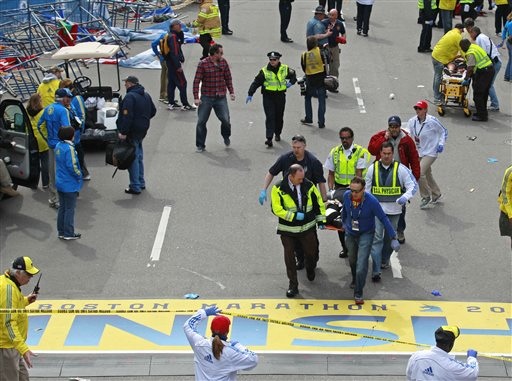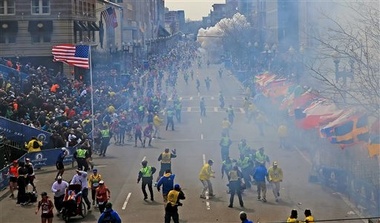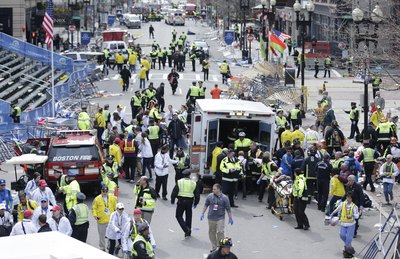Much to do following Boston Marathon explosions

Police and paramedics during the aftermath of the Boston Marathon explosions.
AP photo
The science of working a terrorist bombing incident really is quite interesting. After the victims have been cared for and evacuated from the scene, it is time to start processing the crime scene for evidence.

Scene following explosions during the Boston Marathon on Monday. Three people died and more than 170 were injured.
AP photo
In Israel, I am told the whole scene of a bombing is processed and cleaned up in the matter of several hours. This is done to minimize the psychological effects of a bombing. We in the U.S. on the other hand, do painstaking scene processing because when a suspect is caught, the evidence and scene processing must stand up to the legal tests in our courts.
First and foremost the area will be photographed and videotaped. Police investigators will take scene photographs and videos after the fact, but some of the best evidence will be taken from other sources. The police also will have to measure and diagram the scene for later reconstruction in court if necessary.
Surveillance videos in area stores and businesses, spectator videos and pictures, aerial shots from helicopters, and general media photographic and video images will be analyzed for clues. The images will be painstakingly examined to identify the suspect(s) involved.
Witness statements will be collected by officers by canvassing the area. Spectators and bystanders in the area will hold an important key to the investigation. Investigators must always assume, in any investigation, that “somebody saw something” and that is how they have to conduct their interviews.
The problem in Boston will be locating people who saw something before they head back to their homes all over the nation. It will be incumbent on witnesses with information, videos or photos to call tip lines if they think they have information.
Cellphones will play a key role in this case. Cellphone companies must always know where calls are made from, so cellphone companies can bill for the customer appropriately. Therefore using cellphone company records, law enforcement will be able to ascertain what phones were making calls and in some cases what phones were in the area around the time of the bombing.

Police and ambulances scurry to help after the Boston Marathon bombing on Monday.
AP Photo | Charles Krupa
The air blast is caused by the shockwave created by the rapid chemical reaction that gives off so much energy. The air blast, propels pieces of the bomb and other items around the detonation outward as projectiles called shrapnel.
Injuries from shrapnel are the most obvious at the scene, producing visible wounds to the victims. Air blast injuries are not as obvious. Air blast injuries effect less dense or less solid organs in the body. Air blast injuries primarily effect the ears, lungs and central nervous system, including the brain.
The clothing from bomb victims often contains valuable evidence from the blast. For this reason investigators must retrieve the clothing worn by the victim as well as shrapnel removed from the victims’ bodies, from the hospital.
This evidence might include the chemical compounds of the detonated material. Other evidence taken from victims might show the bombers intent to inflict injury and death. Items such as roofing nails in the Atlanta Centennial Olympic Park Bombings in 1996 or ball bearings in Boston contained in the explosive device act as lethal shrapnel and clearly show a bomber’s intent.
Incidentally a .357 magnum handgun bullet flies at around 1,400 feet per second. The muzzle velocity of a .223 rifle round — which is a common assault rifle round — is about 3,650 feet per second. Shrapnel from a bomb starts out at approximately the same rate as the .223 rifle round and increase depending on the explosive used. The detonation velocity of military C-4Â — or plastic explosives — is 26,400 feet per second.
The point here is that when you see your favorite Hollywood action hero running and diving away from a fiery bomb blast, it is impossible. By the time a person could process seeing or hearing an explosion the shrapnel from the blast already has hit them.
That being said, I once saw an interesting T-shirt on a bomb technician who had responded to the scene of a suspicious package. It said: Bomb Squad — If You See Me Running, Try To Keep Up.
Another very interesting fact about bomb detonations is the evidence and components of the bomb are often times right near where the bomb was detonated. Conventional wisdom would hold that everything involved with the blast would be blown away form ground zero, and indeed it initially is, during what is called the positive pressure pulse. During this phase of the explosion, solid materials are transformed into a gas in 1/10,000th of a second, a shock wave or air blast is sent out from the explosive.
Immediately after the positive pressure pulse, there is a negative pressure pulse, which is caused by the inward rush of displaced air. This causes a vacuum effect, which can pull pieces of the triggering mechanism, which is an important component of the bomb to identify the bomb manufacturer, back into the area of the initial blast. This negative phase if less powerful, but lasts much longer than the positive phase.
This phenomenon is demonstrated in the video of the Boston Bombing. If you closely watch this video of the event, there is a lamp post near the middle of the screen. To the left of the lamp post there is a yellow balloon that blows out and is pulled back into the blast area. Similarly there is a white over red international flag, which is blown out and then are pulled violently back upright in the same area of the screen.
I have confidence in those investigating this terrorist incident. Somebody saw something, somebody knows something or evidence will point in the right direction, but those responsible for this act of murder will be caught.
Please remember this latest act of terrorism and those that came before it the next time you are delayed at airport security or asked to put something back in your car at a large public event you attend. Those delays and requests are necessary for our collective safety.
Lock it up, don’t leave it unattended, be aware and watch out for your neighbors.
Rich Kinsey is a retired Ann Arbor police detective sergeant who now blogs about crime and safety for AnnArbor.com.


Comments
OutfieldDan
Fri, Apr 19, 2013 : 1:40 p.m.
Wow. This is a great report. It's level headed and objective for a change.
Jeremy Miller
Thu, Apr 18, 2013 : 6:41 p.m.
C4 expansion velocity doesn't directly translate into the FPS of shrapnel -- modern USMC claymores (M18), using C4, are less than 4000 FPS (think its 1200 m/sec)... about 10% more than the .223 varmint round. As a side note the 5.56 mm NATO "assault rifle round" actually used in the M16 has a lower muzzle velocity given its a higher grain round than the .223 varmint and despite the increased chamber pressure of a 5.56 mm. I think the 5.56 comes in at around 3000 FPS. Obviously, varying muzzle lengths and rifling twist effect velocity of said rounds. That said comparing muzzle velocities of rifled fired rounds to shrapnel velocities is difficult to justify. Its like saying a quarterback threw a tight spiral and then same quarterback throw up a lame duck... both throws had the same initial velocity but very greatly when comparing the distance traveled or the energy delivered to the receiver.
Jim
Thu, Apr 18, 2013 : 3:25 p.m.
How many pressure cookers (of that type) are sold in the U.S. in a given year?
Jim
Thu, Apr 18, 2013 : 3:28 p.m.
Ugh. 50,000 Mid-Size Fagor pressure cookers sold in the U.S. each year.
deputydwag
Thu, Apr 18, 2013 : 2:46 p.m.
Rich, great column, as usual, making sure we understand the "little" things besides the "big" things we are apt to complain about or focus on.
Billy
Thu, Apr 18, 2013 : 1:47 p.m.
"I have confidence in those investigating this terrorist incident." Which would be THE internet as a whole. So far....places like reddit, 4chan, and others have identified suspects before the authorities have. I saw pictures of the suspected bombers nearly 4 hours before any MSM started to report on them. The thing about this event, is that there is an absolute TON of amateur footage. Go through enough of it and I have a feeling they'll be able to piece the entire scene together from that day. There's so much security footage of that entire area that they'll probably be able to not only identify who dropped off the bombs, but then FOLLOW them and see where they went. We are a LOT further along technologically today than we were during the ATL bombing. Technology is what will be ultimately responsible for catching these individuals.